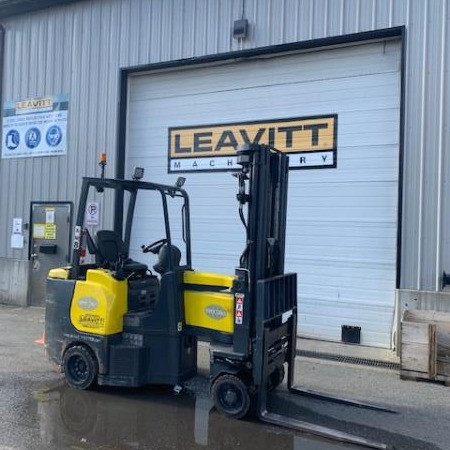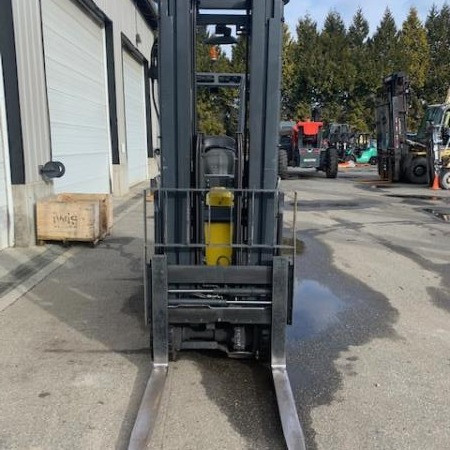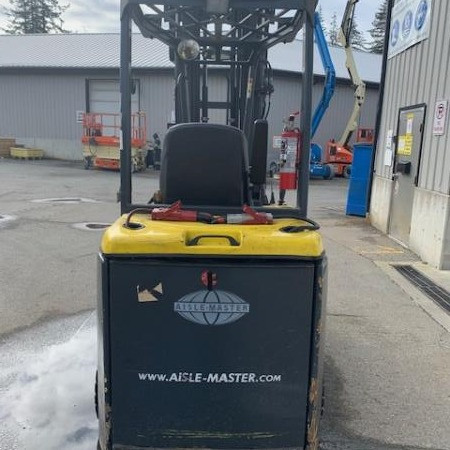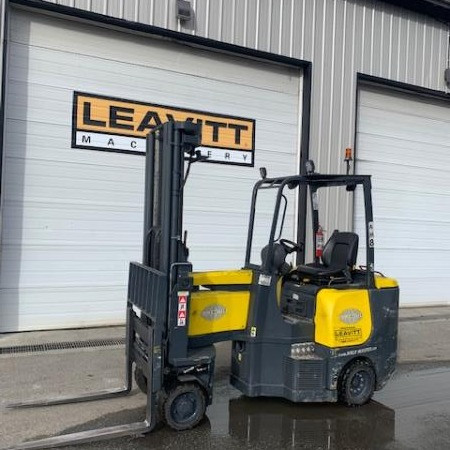Very Narrow Aisle Forklift Tacoma
Used Very Narrow Aisle Forklift Tacoma - Getting items from one warehouse location to another and to and from the loading docks is the focus of warehousing. Focus is often on space saving tools and the layout of the building. Extremely narrow aisles offer more storage space since there is less space needed for aisle access. These warehouse configurations are often referred to as warehouse optimization.
Warehouse Optimization
Implementing very narrow aisle warehouse optimization is a huge benefit of warehouse optimization. One of the most important benefits is the increased storage space.
Using narrow forklift trucks instead of traditional forklifts can enable the warehouse width of the aisles can be lessened to half. Many very narrow aisle forklifts offer greater stack height capability which further increases the storage capacity per square foot. This means that costs are decreased because less warehouse space is necessary for the same amount of stock than if a standard aisle configuration were used. Most urban locations have expensive square footage; therefore, reducing costs is a benefit to warehouses and their business. Adding a very narrow aisle width system can increase storage up to eighty percent when planned properly. Very narrow aisle design facilitates greater product access and more rack faces. Reduced travel time for storing items and gathering products are some of the key benefits to this warehouse layout as more products are found in an accessible location.
Warehouse layouts usually utilize a narrow aisle or very narrow aisle plan. Narrow aisles are usually those that use less than 11 feet of aisle width. Very narrow aisles reduce the aisle width further to around six-and-a-half feet. Both of these aisle widths provide significantly increased storage opportunities. Standard forklifts can have issues with turning in these aisle widths. To meet these challenges, several different types of very narrow forklifts have been specially developed for various types of tasks to allow easier maneuvering in narrow aisle widths.
When selecting a forklift for a job application, it is essential to know the aisle dimensions. It is important to have the correct aisle dimensions before forklift shopping to avoid securing a machine that won’t fit its’ intended location. It is essential to take any columns, posts or utilities into account before deciding a type of narrow aisle forklift design as these can block access.
Very Narrow Aisle Forklift Trucks
Very narrow aisle forklift trucks are almost always powered electrically, usually by rechargeable battery. Stand-up riders are a popular design for very narrow aisle forklift trucks. The most popular kinds of very narrow aisle forklift trucks include turret or swing-mast, end-control riders, order pickers and reach trucks.
Reach Forklift Trucks
Developed as a kind of rider stacker forklift, the reach forklift trucks can be configured for narrow aisle locations. It got its name by its function of reaching its forks forward to get to a load. The two kinds of reach trucks the moving carriage and the moving mast. The moving carriage works by raising and lowering the carriage, along with the operator. The moving mast works by raising and lowering the forks along the mast, while the operator stays at ground level. The moving mast reach truck is generally considered the safer of the two types of reach trucks. Reach trucks use a pantograph system, a type of jointed framework, which allows the operator to reach for or place a load without the need to move the forklift itself.
Order Pickers
Order pickers were created to specifically pick orders from difficult-to-access racks. These machines are used for picking up lighter stock that can be moved by hand. They lift the operator up to reach the goods by identifying and choosing certain items to create an order.
End-Control Riders
End-control riders can pick up loads along the floor level and transport goods horizontally instead of transporting items over heights.
Turret or Swing-Mast Forklift
Swing-mast or turret very narrow aisle forklifts feature an articulating swivel mast that pivots. The mast swivels allowing pallets to be placed on either the left or right of the forklift.
Guided Very Narrow Aisle Trucks
Very narrow aisle forklift trucks can be guided by rail or wire down the aisles.
Thanks to the guide rails, the possibility of crashing into racks is greatly reduced. In rail-guided models, sets of rails are placed into the floor on each side of the aisle. They run the length of the aisle and also curve around the aisles’ edge. The forklift is fitted with special wheel guides that slide into the rails, preventing the forklift from moving outside the rail guards.
Running down the center of the aisle, wire-guidance forklifts rely on floor wires instead of rails. Narrow aisle forklifts rely on a wire-guide system to help it communicate with the floor wires. This allows the machine to be steered by the wires, stopping it from traveling outside of the specific location.
Work Site Considerations
To use a narrow aisle configuration, there are some key considerations that need to be made. The floor and the rack construction needs to be evaluated to avoid any issues since the very narrow aisle units have extremely high racking systems. There are four areas which must be meticulously prepared before setting up a racking system and must be continuously monitored and maintained throughout the operation of the warehousing system:
1. The floor must be level;
2. Cracks must be repaired;
3. Load capacity of floor must be appropriate; and
4. The racks must be plumb.
Level Floor
Due to the racking system height, any minor floor slope can gravely impact how plumb the racks are, particularly over time if loads are placed and removed repeatedly on the racks. The height of the racking system means that any minute floor slope can have a negative impact on how straight the racks are, especially over time when loads are continually removed and placed on the racks. A level floor is vital for the safety and integrity of the operator, employees, stock and the warehouse.
Crack Repair
When cracks in the floor are spotted, they should be assessed and, when necessary, repaired immediately. The level of the floor can become unstable with cracks when they are only 3/8 inches wide. They will need to be filled properly with material as hard as the rest of the floor.
Floor Load Capacity
Minimum flooring requirements must be met before considering a narrow aisle installation. At a minimum, the floor should consist of 3,000 psi concrete as well as contain evenly distributed rebar approximately 3 to 4 inches below the surface. Depending on the load requirements and configuration, additional reinforcements may be needed.
Plumb Racks
Installing the racks safely and correctly is vital for the entire system. Rack failure can happen if they are improperly installed. All racks need to be plumb and this is one of the most vital aspects of correct installation. Rack shims are recommended to make sure the racks are plumb within one inch at the thirty- foot rack height.
If the above measures are not taken or are improperly implemented, it is likely to cause a racking failure. Such failure is likely to result in costly damage to goods, the warehouse facility, forklifts and, worst of all, employees could be significantly injured or even killed. These measurements are vital to the success of installing a safe and productive narrow aisle configuration.
Very Narrow Aisle Forklift PDF
Stock Number: 209213 GL
Make: AISLEMASTER
Model: 44SE
Year: 2015
| Stock Number |
209213 GL |
| Make |
AISLEMASTER |
| Model |
44SE |
| Year |
2015 |
| Category |
Very Narrow Aisle Forklift |
Stock Number: 207213 GL
Make: AISLEMASTER
Model: 44E
Year: 2013
| Stock Number |
207213 GL |
| Make |
AISLEMASTER |
| Model |
44E |
| Year |
2013 |
| Category |
Very Narrow Aisle Forklift |
Stock Number: 208758 GL
Make: AISLEMASTER
Model: 44SE
Year: 2015
| Stock Number |
208758 GL |
| Make |
AISLEMASTER |
| Model |
44SE |
| Year |
2015 |
| Category |
Very Narrow Aisle Forklift |













